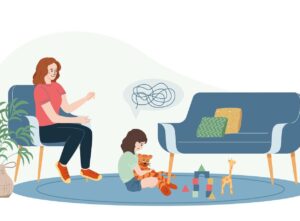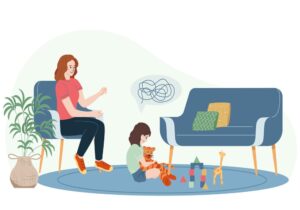A Safe Space for Big Feelings
This article has been researched and written by Moni El Ramlawy. AI has not been used in producing this article.
It’s back to school season. Children and parents alike are navigating more stress – school demands, work pressures, and family responsibilities. When emotions run high, it becomes difficult to channel this energy. This can create a stressful home environment. As adults, stress can look like irritability, withdrawal, or overreacting. For children, it can show up through meltdowns and tantrums.
To regain our sense of calm, what we often need is safety and comfort. This can mean a space (a calm corner) to retreat and come back when we are ready. Creating a calm corner in your home is a space for adults and children to step away and selfsoothe. This corner is not about punishment, and it’s not a “timeout”. It’s a space to pause and regulate.
A stressful home environment can feel overwhelming — child therapy offers tools to restore balance and strengthen emotional connection.
A calm corner doesn’t require much space. It just needs to feel safe and comforting.
How to Create a Calm Corner at Home:
1. Choose the spot: Ideally, choose a quiet corner away from distractions.
2. Make it cozy & comforting: Add cushions and a soft blanket to make the space inviting. Comfort helps the body feel safe.
3. Add fidget tools: Items like stress balls or squishy toys help with restless hands while calming down.
4. Add books: Picture books, breathing tips, or short stories can help shift focus.
5. Soothing extras: Consider adding calming music, or a soft lamp to set a peaceful atmosphere.
It’s important to remind ourselves that people do better when they feel better. Calm spaces help us cool off and feel better.
Extra Pointers:
- Create it together and MAKE IT FUN! Make it a weekend activity.
- Brainstorm how you would like it to look like and what colors you want to add.
- Encourage children to personalize the space with their favorite stuffed animal or drawings – it gives them ownership and makes the corner a positive resource, not a “time-out.”
- Let your children give it a special and playful name.
- A calm corner works best when introduced in a positive way, and not when your child is already in the heat of the moment.
- After it has already been introduced, when they are upset, ask “Would it help to go to your __________ place?”
- Model using the calm corner when you are upset. When children observe their parents using it, it teaches them that it’s a healthy coping strategy, and not a punishment. Modeling the behavior means encouraging it rather than enforcing it.
If you would like to share photos of your calm corners with us, we’d love to see them! Please feel free to send them via WhatsApp or email, or even if you’d like to post it on social media and tag us – go for it!
Every family needs a corner where it’s okay to fall apart and still be loved. If that space doesn’t exist yet, maybe today is the day to start creating it.
How to Talk to Your Child About Body Safety – Without Creating Fear
Body safety talks don’t have to be and shouldn’t be scary. When these conversations are calm …
ADHD in Girls vs. Boys: Why Symptoms Often Look Different
When people think of ADHD, they often picture a young boy bouncing off the walls, constantly moving, talking out of turn, or …
How Psychoeducational Assessments Help Shape Better Learning Plans in School
No two children are the same. Every child brings a unique mix of strengths, challenges, and ways of …
Can Relationship Counseling Work for Toxic Relationships?
Relationships can be complicated, emotional, and at times, painful. While every couple experiences ups and downs, some relationships …
10 Signs You May Have Anxiety
Anxiety is a normal and natural human response to stress, danger, or uncertainty. However, when anxiety becomes excessive, it can …
Child Sleepwalking and Talking: What You Need to Know
Childhood is a time of rapid development, filled with new experiences—and sometimes, surprising nighttime behaviors.
Questions a Child Psychologist Might Ask
When preparing for your child’s first appointment with a psychologist, it’s natural to feel curious—or even a little anxious—about what …
55 Love Questions for Couples to Deepen Your Relationship
In any relationship, communication is key. Whether you’re just starting out or have been together for years, asking meaningful
Stress vs. Anxiety vs. Burnout: How to Recognize the Difference
In today’s fast-paced world, understanding the differences between stress, anxiety, and burnout is crucial for …
Relocation Depression: Definition and Ways to Cope
Relocation depression, also known as moving depression, is a form of situational depression that arises from the stress …











